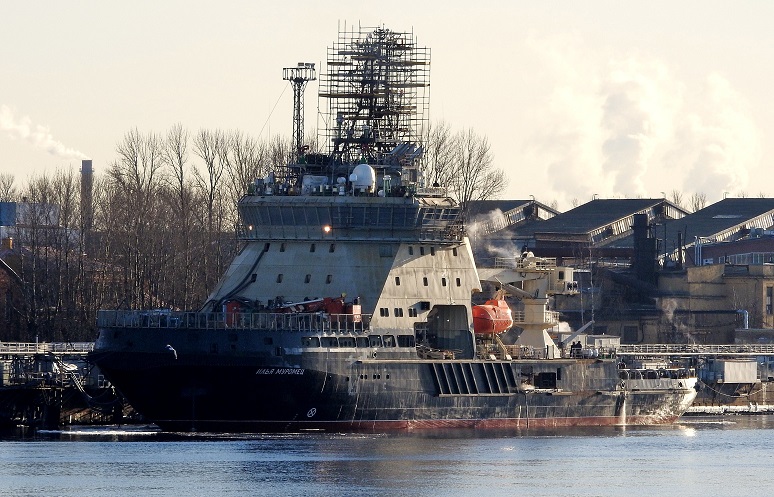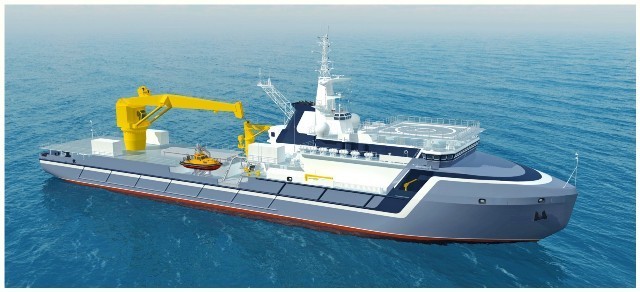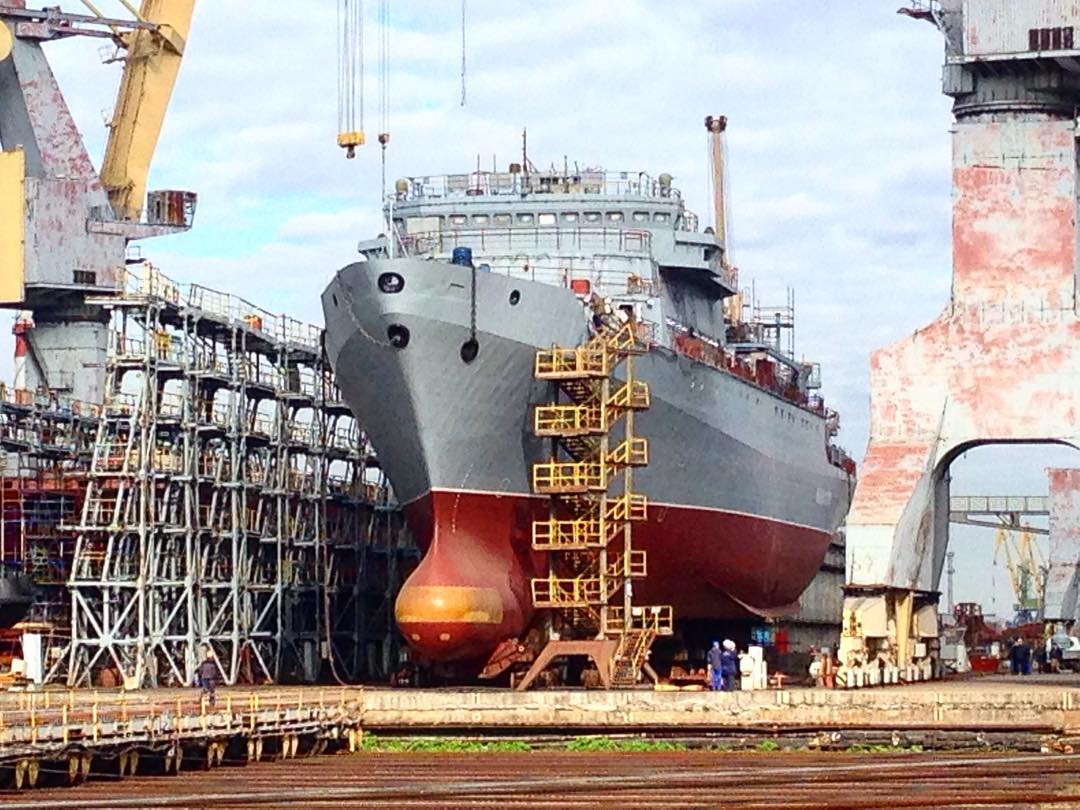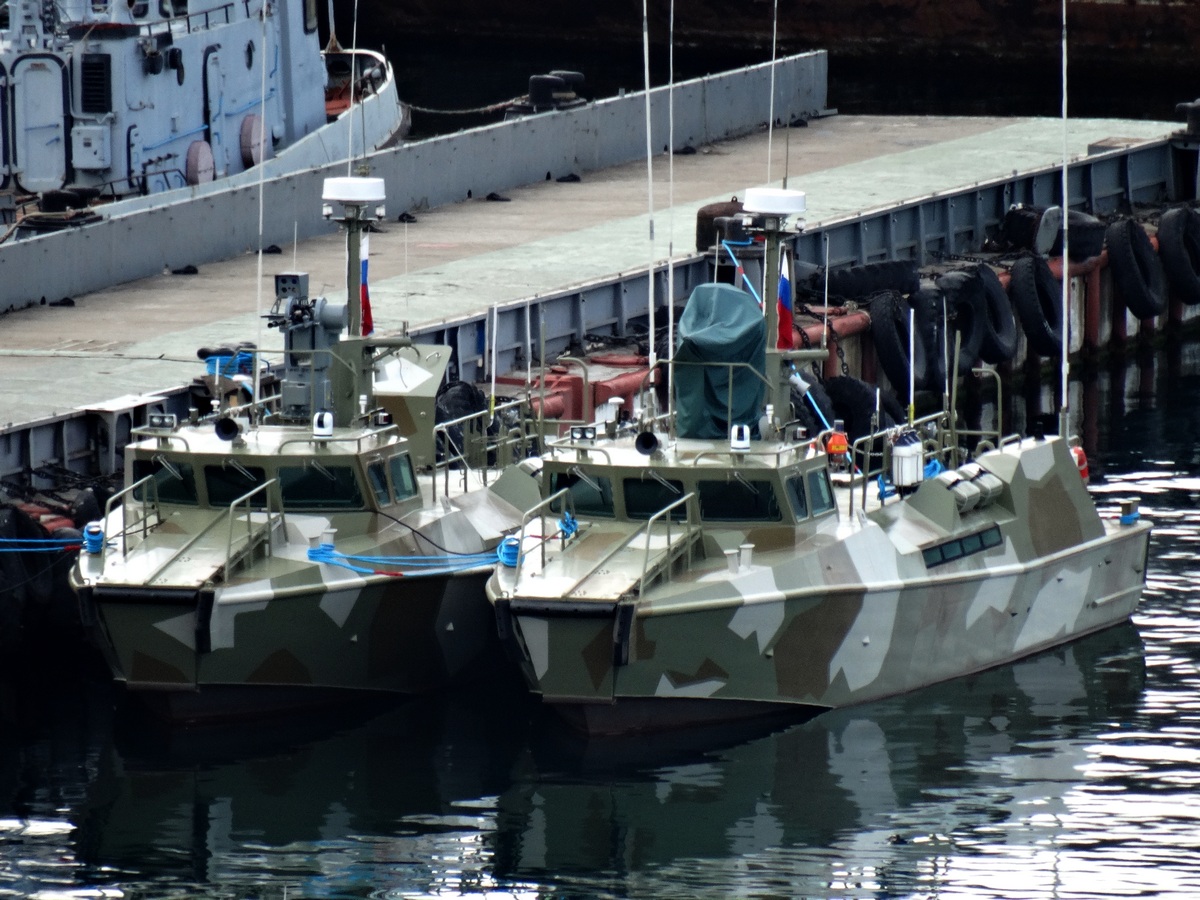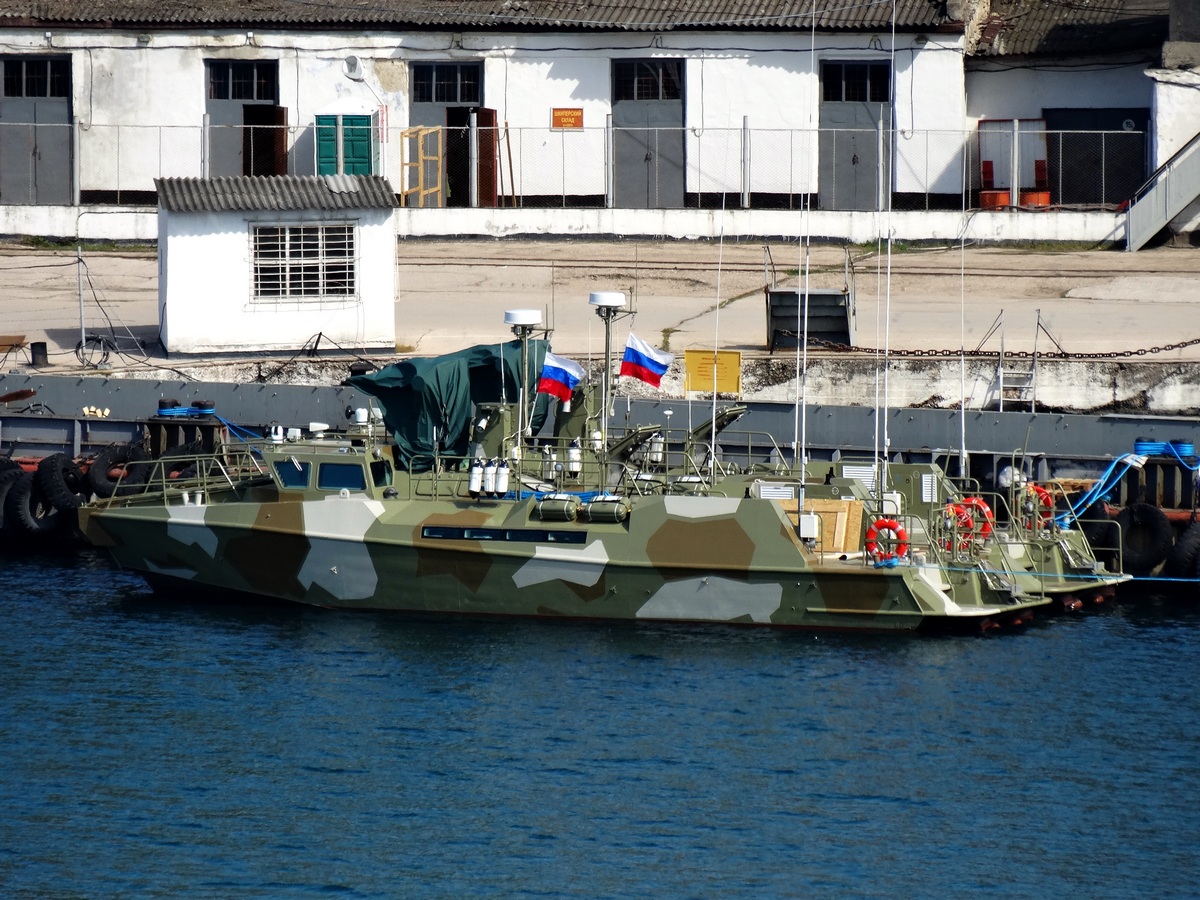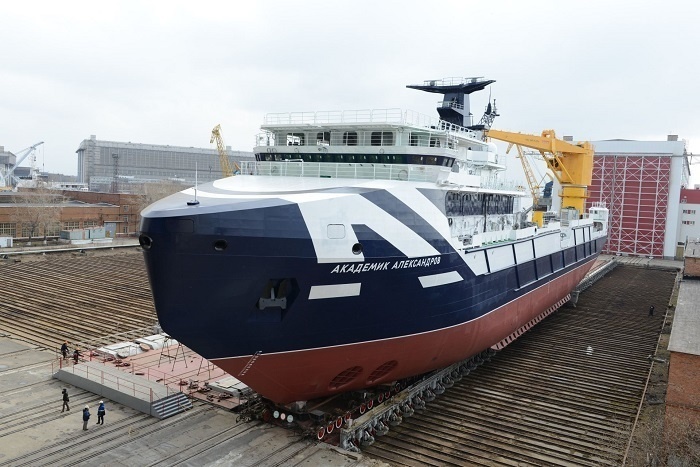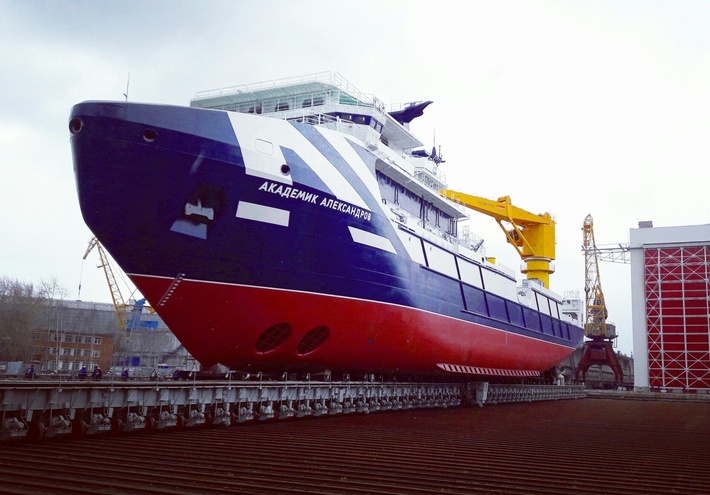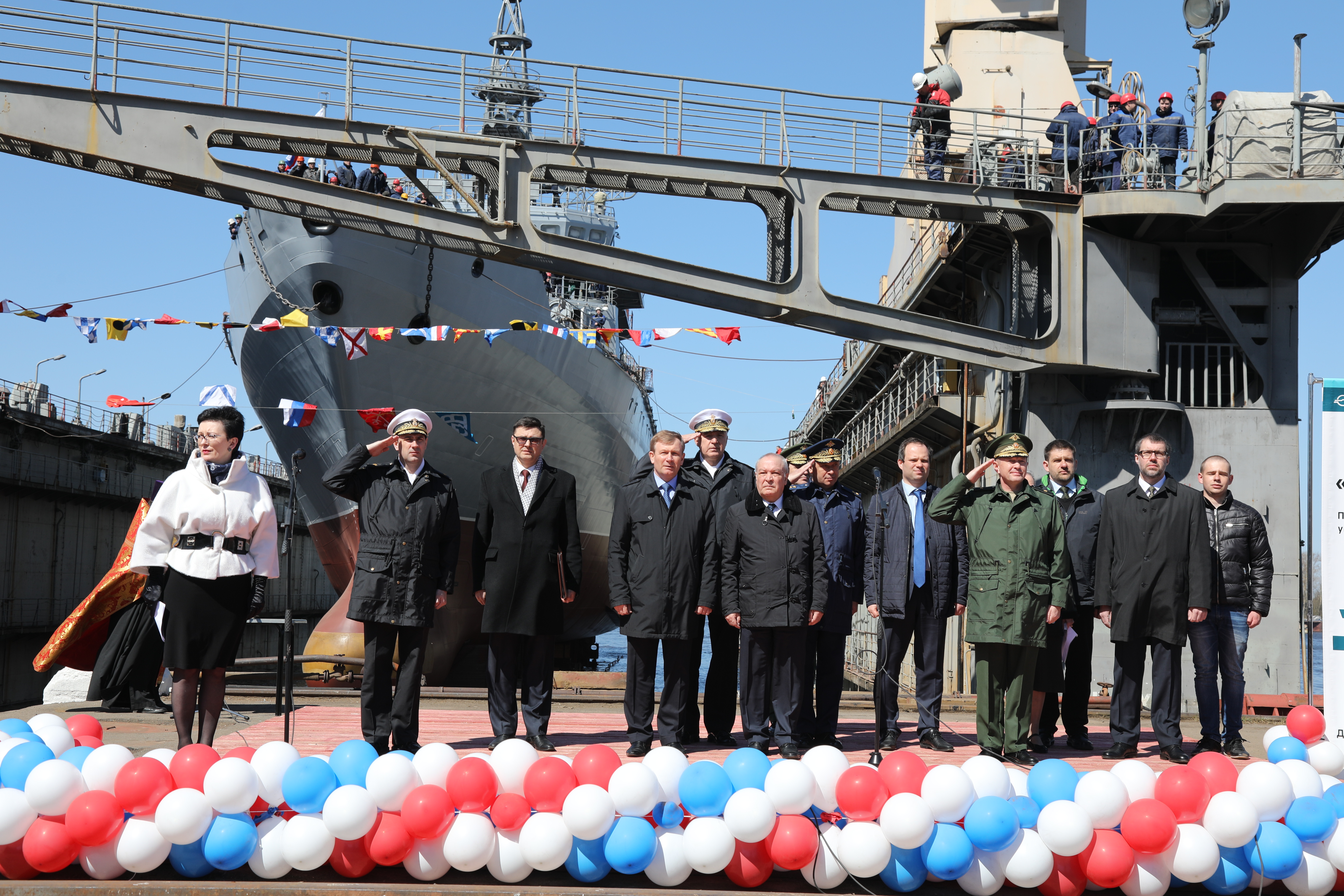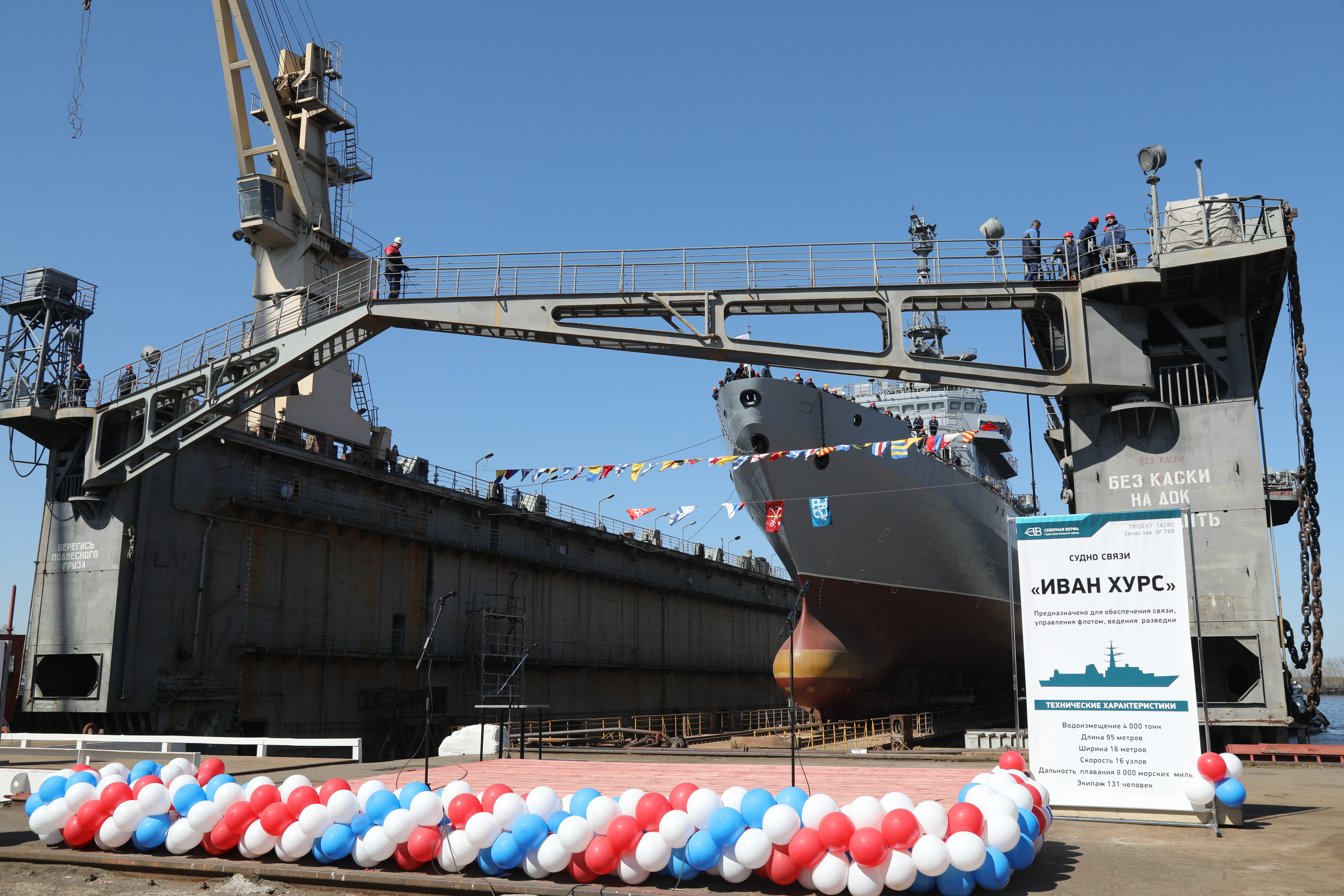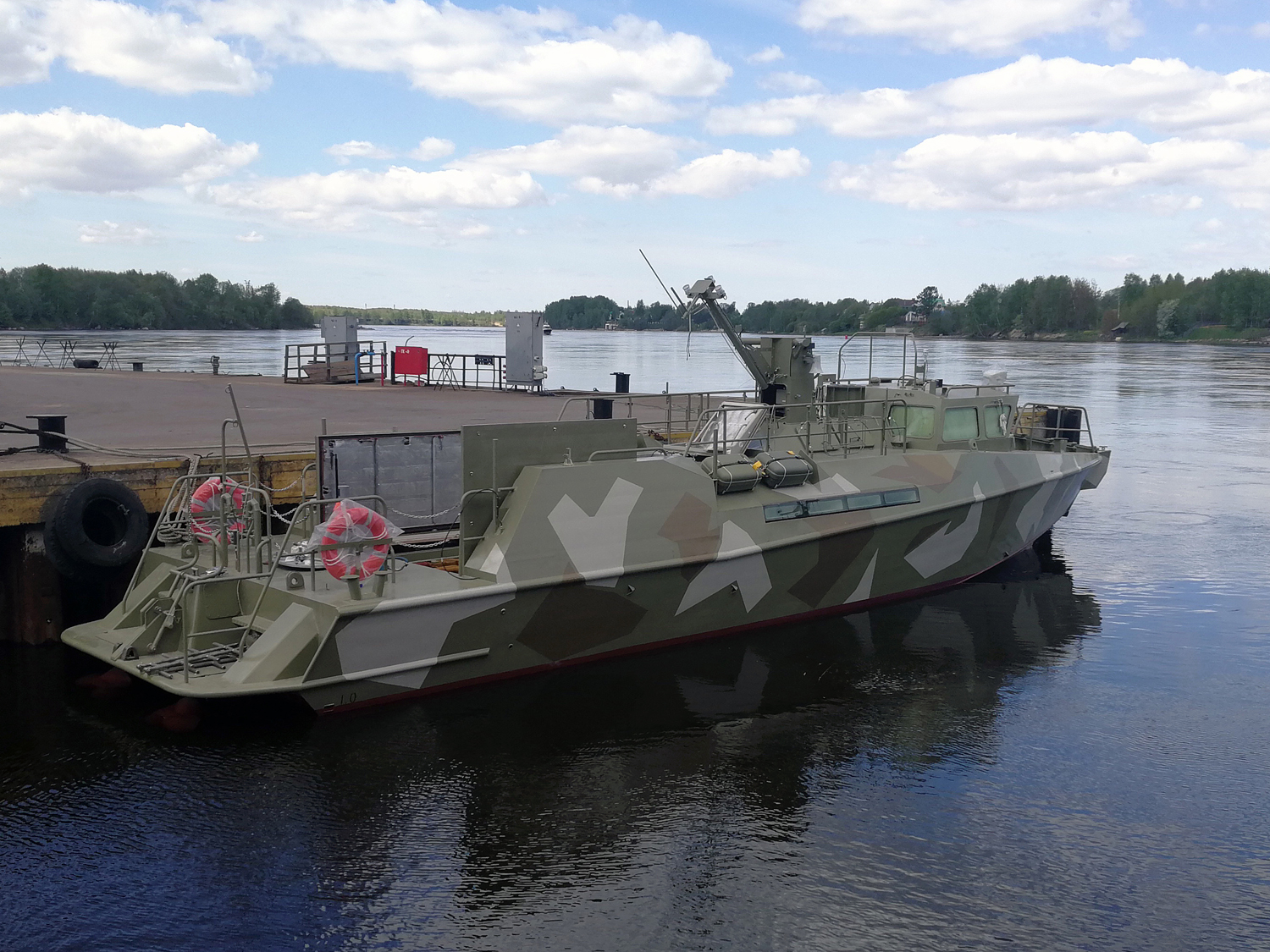Two interesting analyses summing up the current status and future of Russia's auxiliary – mainly icebreaker – fleet.
It's first part...
Focus: Russia beefing up its ice-rated vessel fleet in the Arctic - Part IIn recent years, there has been an active build-up of Russia’s ice-rated ships fleet designed for for operations in the Arctic. In particular, the Almaz Design Bureau has developed the unique Project 23550 patrol ship capable of executing in the icebreaker, tug and patrol ship roles.
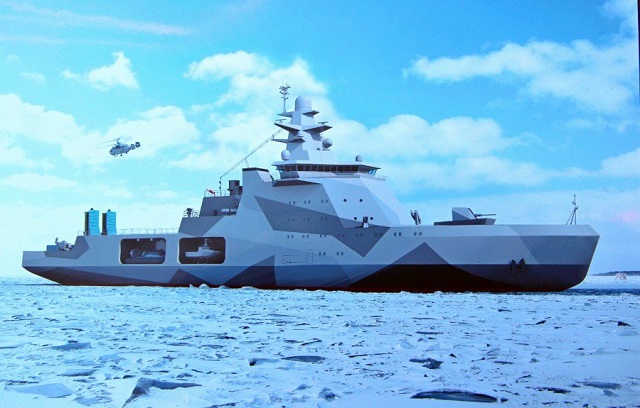 Artist impresson of Project 23550 ice-class patrol ship . Image: Russian Defense Ministry.
Artist impresson of Project 23550 ice-class patrol ship . Image: Russian Defense Ministry.The Admiralty Wharfs Shipyard in St. Petersburg has laid the keel of the lead ship of the Project 23550 class, the Ivan Papanin ice-class patrol corvette intended for the Russian Navy.
"Today is a special day for the Navy and military shipbuilders. Today is the birthday of the ship that is designed to guard our Arctic expanses. The ice-class patrol ship will be built by order of the Russian defense minister to pursue this country’s interests in the Arctic strategic area," Russian Navy Commander-in-Chief Admiral Vladimir Korolyov said, adding that the second ship in the class would be laid down soon. It will be named after polar explorer Nikolai Zubov.
The weapons equipping the second ship will differ from those of the lead ship, which weapons suite has not been determined yet. An important element of it will be the deck-based armed helicopter, Korolyov added.
"The Ivan Papanin icebreaker is slated for delivery in late 2020 or early 2021. It is based on Russian technologies only," the service chief added. The second ice-rated corvette is due for keel laying in late 2017 or in early 2018.
The development of the advanced ice-rated versatile patrol ship was announced in April 2015. At the time, then-Navy Commander-in-Chief Admiral Victor Chirkov said that the Russian naval force operating in the Arctic would be given a versatile ship capable of doing three jobs at once - icebreaker, tug and patrol ship.
"A decision has been made to design and build a unique new-generation versatile ship fit for the seagoing tug, icebreaker and patrol ship roles at the same time. The versatility will enable her to execute a wide range of missions in the Arctic. This year, we shall make up our mind on her design," Chirkov said.
Russian Navy Deputy Commander-in-Chief Alexander Fedotenkov told journalists in January 2016 that "a drastically advanced Project 23550 ice-rated ship triple-hatted as tug, icebreaker and patrol ship" was to be laid down some time this year.
 Project 23550 ice-class patrol ship fitted with 100mm main gun and Kalibr cruise missile launchers will be closer to a corvette rather a mere patrol vessel. Image: Russian Defense Ministry.
Project 23550 ice-class patrol ship fitted with 100mm main gun and Kalibr cruise missile launchers will be closer to a corvette rather a mere patrol vessel. Image: Russian Defense Ministry.In May 2016, the military ordered two Project 23550 patrol ships from Admiralty Wharfs.
"Under the contract, the ships are to be delivered to the Navy before year-end 2020," a Defense Ministry official said, adding that the order had been awarded under the 2020 Defense Procurement Program.
The ice-rated patrol ship’s design was unveiled at the Army 2015 International Military-Technical Forum and IMDS 2015 International Maritime Defense Show in St. Petersburg. A model of the ship was exhibited during Army 2015. According to the developer and open sources, the advanced class is intended for guarding and monitoring the Russian sector of the Arctic, especially Russia’s exclusive economic zone; escorting or towing poacher vessels seized within the Russian exclusive economic zone; escorting and supporting auxiliary vessels; participating in rescue operations; recovering vessels that run aground; carrying special cargo in containers on the upper deck; and engaging naval, coastal and aerial targets with her weapons. The Almaz Design Bureau has classified its new ship as Arc 6 AUT1 FF3WS EPP Special Purpose Ship ANTI-ICE DYNPOS-1 HELIDECK-H as per the Russian Maritime Register of Shipping.
The ship can effectively operate in the Arctic both solo and as part of a formation and is capable of escort missions on sea lanes in the Arctic.
According to Almaz and open sources, the Project 23550 ice-rated patrol ship measures about 100 m long and about 20 m abeam, with a maximum draft of around 6 m. It displaces 8,500 tons and has a cruising range of approximately 6,000 nm and a maximum icebreaking capability of 1.5 m (1 m if moving continuously). Its speed equals around 16 knots. The ice-rated corvette has a 15,000kW power plant. Its propulsion unit includes two Azipod Vi1600L electric podded azimuth thrusters or similar ones about 6,000kW each and Schottel STT2 side thrusters or similar ones around 500kW each. The ship is furnished with a tow rig with a pull of at least 80 tons-force and two electrohydraulic cranes with a lifting capacity of about 28 tons each. There is a main crew of about 60, with 50 seamen more to be carried if needed. The self-contained operating capability is around 60 days. The area of operations is unlimited
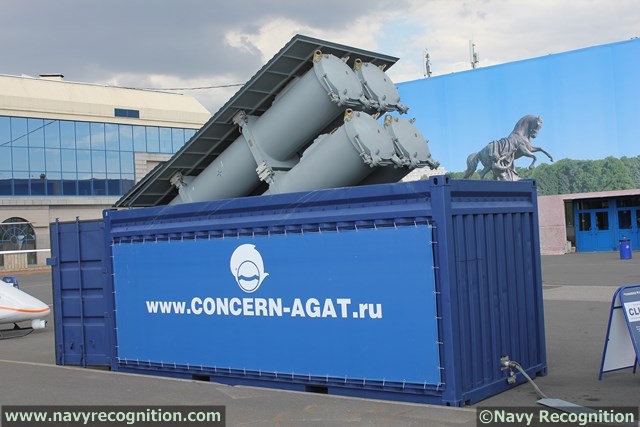 Project 23550 ice-class patrol ships are likely to be fitted with the contenairized variant of the Kalibr cruise missile system (Club-K).
Project 23550 ice-class patrol ships are likely to be fitted with the contenairized variant of the Kalibr cruise missile system (Club-K).According to open sources, the weapons suite of the Project 23550 patrol ship comprises the Kalibr (NATO reporting name: SS-N-27 Sizzler) guided missile system, guns, two Project 03160 Raptor patrol boats and a Kamov Ka-27 (Helix) helicopter. In all probability, the lead ship will lack the missile system, but the second one will differ from her in terms of weapons, and its weapons suite is yet to be decided on. The pictures published by Almaz show two Kalibr missile system modules at the stern, each comprising four launch tubes. In addition, a 76-mm AK-176MA versatile gun will be mounted at the bow. The press office of the Arsenal Company has said in March 2017 that the AK-176MA had been designed for littoral combat ships and added to the weapons suites of advanced combatants, including those in the Project 23550 class.
The weapons suite also includes two Project 03160 landing craft designed for operating near the coast round the clock. The craft are capable of landing Marines (at least 20 each) on the shore or on any other object. They can patrol assigned areas of water, intercept and seize small-size craft and conduct search and rescue. The Raptor is crewed by three and armed with a fighting module comprising a 14.5-mm machinegun, a gyro-stabilized electro-optical module and a fire control system.
The Project 23550 patrol ship can accommodate a helicopter on a helipad at the stern fore of the Kalibr launchers. Probably, the ship also has a helicopter hangar in front of the helipad. According to open sources, the ship can carry the Ka-27PL (Helix-A), but it is very likely that she also can accommodate the search-and-rescue Ka-27PS, transport/assault Ka-29 (Helix-B), radar-picket Ka-31 (Helix-E) and Ka-35, their upgraded variants and Ka-52 (Hokum-B) armed reconnaissance helicopter. The latter can use guided missiles, e.g. the Kh-31 (AS-17 Krypton) and Kh-35 (AS-20 Kayak) antiship missiles.
As of now, open sources have provided no information on the air and antisubmarine defense systems of the Russian advanced ice-rated patrol ship. Presumably, she will mount a navalized version of the Tor (SA-15 Gauntlet) surface-to-air missile system, which is in trials now, or the Pantsir-M (SA-22 Greyhound) anti-air gun/missile system. The Project 23550 patrol ship may be equipped with the Paket small-size system with 324-mm torpedo tubes and an ammunition load including anti-torpedoes. Fitting the ship with 533-mm torpedo tubes does not look reasonable. At the same time, her weapons suite should incorporate anti-torpedo rocket launchers
Source:

http://www.navyrecognition.com/index.php/focus-analysis/naval-technology/5165-focus-russia-beefing-up-its-ice-rated-vessel-fleet-in-the-arctic-part-i.html
...and here is the second part.
Focus: Russia beefing up its ice-rated vessel fleet in the Arctic - Part IIThere has been an active build-up of the ice-rated ships fleet by Russia in support of its operations in the Arctic in recent years. Russia is developing several icebreakers differing in power and displacement, with some of them intended for the Navy. The efforts are especially important owing to the country’s ramping up its operations in the Arctic.

The First Project 21180 Icebreaker Ilya Muromets. Picture: JSC Admiralty Shipyard
The Krylov State Research Center set up the Arctic Engineering Center (AEC) in 2016, according to Krylov’s Director General Vladimir Nikitin. He said the new division was continuously in touch with both major energy companies and the Russian Defense Ministry. A whole range of federal programs is being pursued as part of this cooperation, including the development of icebreakers, support vessels and other marine hardware.
Admiralty Wharfs laid the keel of the Russian Navy-ordered Project 21180 lead ship, the Ilya Muromets icebreaker, in St. Petersburg in April 2015 and launched it in June 2016. The icebreaker is planned for commissioning in the fall of 2017 after it passes its tests. The Ilya Muromets has become the first icebreaker being built for the Navy over the past 45 years. In the fall of 2017, it will head for the Northern Fleet, which Arctic operations it will support further down the road. The ship is able to lead surface combatants and auxiliary vessels through the ice or tow them, if need be. It is tripled-hatted as seagoing tug, icebreaker and patrol ship.
According to the non-nuclear icebreaker’s requirements specification, it will be able to negotiate 80-centimeter-thick ice. Presumably, its endurance will stand at 60 days, cruising range at 12,000 nm, displacement at 6,000 tons, length at 84 m, beam at 20 m and draft at 7 m. The Ilya Muromets is Russia’s first icebreaker with Azipod thrusters hinged outside of the hull and able to traverse 360 deg. Its crew will be 32.
 Artist impression of nuclear powered icebreaker "Arktika" (project 22220)
Artist impression of nuclear powered icebreaker "Arktika" (project 22220)
Image: AtomflotAt the same time, the Russian Navy has no plans for nuclear icebreakers. Hence, the ones owned by the Rosatom State Atomic Energy Corporation will be used in the interests of the military. In July 2016, Rosatom Director General Sergei Kiriyenko said the job of its advanced Project 22220 icebreakers included leading naval convoys in the Arctic. The Project 22220 class is important to Russia’s defense and competitiveness as far as the Northern Sea Route transit is concerned. The Baltic Shipyard laid down the lead ship in the class, the Arktika, in November 2013. The cost of the class is estimated at 122 billion rubles ($2 billion). Technologies totally novel to nuclear warships have been used as part of its construction. Its variable-depth dual draft will allow leading convoys both on the high seas and in estuaries while its sophisticated nuclear reactor will necessitate port calls for intermediate recharging less than once every six months. Presumably, the icebreaker will be able to do without reactor reloading for about seven years.
The Iceberg Design Bureau plans to deliver three Project 22220 nuclear-powered icebreakers prior to 2020. In addition, it is designing other advanced icebreakers, Iceberg Director General/Chief Designer Alexander Ryzhkov told TASS in December 2015.
"The Baltic Shipyard is building Project 22220 nuclear icebreakers. Three are to be delivered to government-owned Atomflot prior to 2020. These are unique vessels equipped an advanced monoblock reactor, a sophisticated steam-turbine plant, an electric propulsion system and latest automatic mechanisms. The icebreaker varies her draft within the 8.5-10.5-m bracket, which enables her to operate both on the Northern Sea Route and in the estuaries of Siberian rivers," Ryzhkov says.
With the 10.5-m maximum draft, the class has an ice-breaking capability of 2.8-3 m and, thus, is fit for operations in the east of the Arctic all year round. The solutions embodied by the Project 22220 icebreakers makes them fit for replacing two icebreaker classes simultaneously - the seagoing Project 10521 Yamal and 50 Let Pobedy and the shallow-draft Project 10580 Taimyr and Vaigach. Rosatom may order two more Project 22220 versatile icebreakers from the United Shipbuilding Corporation (USC), according to the materials the Industry and Trade Ministry prepared for a session of the government’s Arctic board.
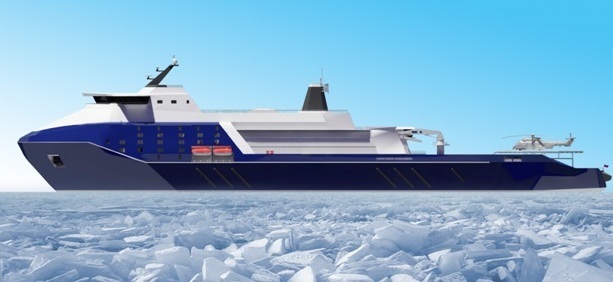 Project 10510 Leader class
Project 10510 Leader classThe Iceberg Design Bureau also is developing the world’s most powerful nuclear icebreaker of the Project 10510 Leader class. According to Ryzhkov,
"its power is 120MW and its maximum ice-breaking capability equals 4.3 m, and if ice is 2 m thick, the ship can lead convoys at a speed of more than 11 knots, thus ensuring cost-effective traffic via the Northern Sea Route." The cooperation with the Krylov Center has yielded the icebreaker’s conceptual design and ice tank tests have been conducted. Russian shipyards will be prepared to launch the construction of the 120MW icebreaker in 2017. According to Industry and Trade Deputy Minister Vassily Osmakov, some opine that the three icebreakers under construction will be able to meet only part of the needs of the region.
"Therefore, in order to maintain the leadership and be able to launch the program at the drop of a hat, the Iceberg Design Bureau came up with the conceptual design of the Leader icebreaker and has been working on the engineering design of the Leader LK-120 nuclear icebreaker. Its engineering design is due in December 2017. I think the completion of the engineering design will hasten the ship’s entry into production," he said. The construction may take three years and a half.
"We will be ready in terms of construction technology from late 2018," USC President Alexei Rakhmanov said. According to him, the job may be handled either by the Baltic Shipyard or by the Severnaya Verf Shipyard, with the outfitting to be performed by the Baltic Shipyard in the latter case. The engineering design is due by 2019 and the vessel is to be delivered by 2024.
 The 40MW multirole offshore nuclear-powered Project 10570 class
The 40MW multirole offshore nuclear-powered Project 10570 classAnother icebreaker class being developed by Iceberg is the 40MW multirole offshore nuclear-powered Project 10570 class. Its design relies on the commonized basic platform vessel concept providing for versions differing in layout, hull, power plant, prop/steering unit, Dynpos-2 dynamic positioning system, to name just a few. The concept will allow developing icebreakers based on common design solutions and capable of a wide range of Arctic offshore works. This will reduce the design and construction costs.
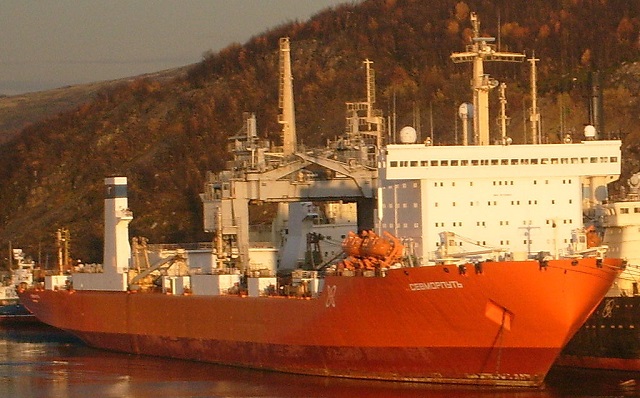 Project 10081 Sevmorput nuclear-powered container carrier
Project 10081 Sevmorput nuclear-powered container carrierIn addition, the Project 10081 Sevmorput nuclear-powered lighter/container carrier has been used in the interest of the Russian Defense Ministry. She is Russia’s only nuclear-powered icebreaker/carrier designed by the Baltsudoproyekt Design Bureau in 1978 and built by the Zaliv Shipyard in the city of Kerch by order of the Soviet government. After having been commissioned, the vessel operated both international and domestic services along the Northern Sea Route. She had been berthed in Murmansk since the 2000s before a decision to renovate her was made in 2013. The Sevmorput displaces 61,880 tons, measures 260 m long and produces 20.8 knots at full speed. Her main turbine-geared propulsion unit has a power of 29,480kW. The vessel carries 74 lighters with a carrying capacity of 300 tons or 1,328 cargo containers.
Andrei Obukhov, chief and chief designer of the Krylov Center’s Baltsudoproyekt division, said in September 2015 that the Sevmorput was being heavily upgraded for various purposes, including for the governmental Arctic development program. According to him, the Sevmorput can be used for many purposes, e.g. in support of transport security, because she is an ice-rated vessel able to haul cargo of various dimensions on the Northern Sea Route.
"In particular, the vessel may carry cargo for both under-construction and completed maritime facilities in the Arctic or remove hazardous waste via an ice cover 1 m thick," Obukhov stressed.
The upgrade launched in December 2013 had been ordered by Atomflot. The vessel was rebuilt in line with the latest stringent nuclear safety and environmental friendliness standards and was afforded advanced shipboard equipment for use in support of the construction and modernization of the airfields and posts throughout the Far North.
The press office of the Russian Navy’s Northern Fleet said in May 2016 that the vessels charted by the military, including the Sevmorput lighter/container carrier, had started shipping cargo for the development of military infrastructure on Arctic islands. The Sevmorput brought from Murmansk to Kotelny Island (New Siberian Islands) 6,000 tons of construction materials for the Northern Shamrock military base.
Source:

http://www.navyrecognition.com/index.php/focus-analysis/naval-technology/5223-focus-russia-beefing-up-its-ice-rated-vessel-fleet-in-the-arctic-part-ii.html











 PapaDragon
PapaDragon
